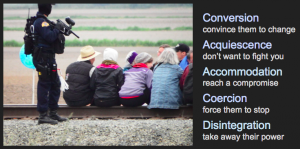Five complex, challenging things you can do about climate change
October 31st, 2017 by Fossil Fuel Resistance Network
“Finding the right framing for ‘We’re all going to die!’” made the case that public cognitive dissonance on environmental issues is, at least partially, an inevitable result of major environmental groups’ insistence on language and agenda that is non-disruptive, and thus incongruous with the physical reality of crisis. The strategic implication: “It is time for a mass exodus of money and popular support from major environmental organizations, who by any conceivable biophysical metric have pursued a decisively failed strategy.”
Naturally, the world isn’t going to get any better if everyone simply withdraws money and support from major environmental groups, and does nothing subsequently. The subsequent work described here is more involved and demanding than giving money, attending events others plan, or showing up at meetings occasionally. It is written with people in mind who are evaluating the physical deterioration happening around them, and the nonexistent societal response, and realizing with euphoria and horror that they actually have to make a choice about running off on an unlikely adventure in global salvation or continuing to watch stylish thrillers on Netflix.
In opposition to the “Five simple, easy things you can do…” format, here’s item #1 from our list of uniquely burdensome and fabulously complex things to do about the climate crisis. We’ll do one every day or so.
#1. Find your own agency.
Political organizing often functions best in places, like Bolivia or Rojava or Pine Ridge, where there is strong existing social infrastructure to provide a substrate from which movements can develop when needed. Arguably, the precise form of social infrastructure–labor union, church, shared subsistence economy, village square–matters less than that people have a way to meet and talk.
We live busy lives, often far from where we were born, and many of us don’t have the ability to call a meeting or take collective action on much of anything–certainly not something infinite and terrifying. The question of with whom to organize, along what lines, is fundamental, and it isn’t necessarily easy to answer. It’s a significant barrier to long-term political engagement of all kinds. People show up at a meeting or two (or a hundred) for one group or another but feel it’s not right for them. Often, people find themselves trying to come to terms on principles or overcome differences of personality in the group that’s available, rather than taking the more difficult path of finding numbers among people with a sufficient shared perspective to drive action.
Of course, it’s important we all keep learning from each other. That’s what mass movements are for. We learn best when we all have agency to pursue our visions, in functional groups, and we can interact with other groups in larger movement contexts. A functional grouping should consist of people who have conversations at the outset establishing they can plausibly get from a first meeting to an action of some kind together.
This isn’t to say that one shouldn’t explore existing groups, but we need more groups. If there is a tone, tactic, or fundamental task that seems to currently be lacking in the existing loose assemblage of groups and people fighting fossil fuels, it probably is. It might be your work to use your voice and cohere people around this vision or perspective.
Immediately after the Trump election, many nascent, ad-hoc groups formed, and many mobilizations were called by new, brash voices. This caused plenty of anguish, and in some cases formal criticisms, by long-term organizers. But the mistake new people made wasn’t forming new groups or finding distinctive approaches; it was not studying the existing movement landscape. Remember this is a list of complex, challenging things–the task at hand is forming functional relationships within the movement, identifying gaps, and mobilizing people to unaddressed tasks, unused tactics, unexplored rhetorical landscapes.
The work isn’t as complex or challenging is it should be, because the gaps are numerous and wide. If a movement for the future is to emerge and have any meaningful impact, it will be chaotic, diverse, and engage people’s unique abilities and obsessive natures. There’s infinite work to be done which is perfectly suited for prodigious talents currently occupied by less interesting or meaningful tasks. Decarbonization pathways are sitting around in various state and city climate action plans, written by small, demoralized staffs constrained by market logic and political “reality,” waiting to be vitalized by people currently showing off math skills in engineering forums on the internet. Small but extant budgets for energy efficiency retrofitting and distributed renewable installation exist, waiting to be tapped by ecological labor forces organized to agitate for these budgets to expand (so that renewables can reach penetration and people otherwise jobless between oil train blockades can eat).
At least in the Pacific Northwest, these are things no one is doing at all, and a list of such things goes on for a very, very long time. It reflects the fundamental smallness of the climate movement with respect to its mandate. The challenge is to convince people that putting their energy, talent and desire to shine into a desperate collective adventure for life is more rewarding and interesting than whatever they happen to be doing currently.
If you haven’t organized ever, or recently, are participating in the formation of a new group, and are trying to get a sense of what adventures your nascent crew might go on, getting direct action/strategic campaigning training as a group can be useful. In most (many?) areas you should be able to find someone willing to provide such a training. They vary in utility and coherence, but they should always give some tentative indications of potential courses of action for a group, as well as significant differences among members.

Direct action training slide showing five responses from power holders.
Two particularly useful exercises for new groups are power mapping and developing a theory of power relations. The image above is from a FFRN direct action training on the latter. It reduces to a series of questions of the form: “Is Power Holder X relevant, and if yes, are we trying to appeal to their humanity? Embarrass them politically? Create an economic or logistical crisis for them?” We escape monolithic generalizations because the answers should vary by target (unless your targets are all from the Tea Party or all from progressive West Coast cities, but the point is obvious–both California Governor Jerry Brown and President Donald Trump are presiding over climate-destroying economies, but questions of acquiescence and accommodation seem a lot more relevant with Brown than with Trump).
It might seem like a bizarrely specific thing to suggest a new group focus on, but we often find ourselves exclusively focused on one path to victory over the other, exclusively conceiving of action around it, and in political conflict with other people in our groups as a result. Usually, this fundamental question–what power holders are we influencing, how will they respond?–is debated through a baffling array of proxy issues. The most famous and discordant of these is the decades-long discussion on the theme of violence and nonviolence, but there are many lesser ones (e.g. “mask up or no?”; “media coverage of central importance or no?”; “action symbolic or directly impactful?”) which are all highly correlated, can mostly be ultimately reduced to broad disagreement about power relations, and can devour otherwise viable efforts.
Power mapping is a logical corollary, and can help a new group formally define what both the major institutional power holders are doing as well as what gaps in the movement it is trying to fill. In its most pure and useful form, it progresses into action planning without anyone noticing. There are a few visualization tools for power mapping, like this and this, but what’s more important than a particular tool is the explicit, collective process of identifying all the existing power holders and the relationships between them (a pen and a piece of paper usually works).
When all the steps for determining a course of action for a group have been taken, all that remains is accessing the resources, infrastructure and time to make it happen. Websites need to go up, emails sent out, people bailed out of jail, reports released, banners painted–all of which requires money and time, far more of it than anyone “has” by our current conventions.
One way to think of a serious movement for the future, a movement with the ability to substantially shift the global trajectory, is to imagine it as a movement comprised of people who were almost all doing something else a few years before. The notion of a WWII-style mobilization in response to climate change is often invoked, but almost solely in terms of major industrial and economic restructuring with federal oversight. The comparison continues to be valid if we extend it to the mobilization and sacrifice of people during WWII.
Whatever the implementing details, this is the essence of finding your own agency, the overarching criterion for every other aspect–acknowledging that the task at hand is exceptionally difficult, and addressing oneself to it nonetheless.
That concludes part one of the Five Difficult Things list. To summarize: identify gaps in the existing movement landscape, overcome any psychosocial inhibitions you may have to organizing people, get people to come to coherent terms with the issues they always argue about most, find a pile of money or give up a pile of your own, sacrifice all your time, and stay tuned for part two.
